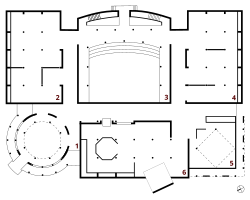Chimtou Archaeological Museum

|
|
| Data | |
|---|---|
| place | Chimtou, Tunisia |
| Art |
Archeology, geology
|
| architect | Jan Martin Klessing |
| opening | 1997 |
| Website | |
The Chimtou Archaeological Museum (municipality of Soukh El Jomma, Jendouba Governorate ) is located in the area of the ancient city of Simitthu / Chimtou in northwestern Tunisia . It was built on the initiative of the Tunisian Institute National du Patrimoine (INP) and the German Archaeological Institute (DAI) and inaugurated in 1997.
history
The focus of the museum is on the results of the German-Tunisian research work from 1965 to 1995 in the ancient city of Simitthu / Chimtou. Topics include the regional geology of northwest Tunisia, the prehistory of Simitthu from 500 to 100 BC. BC, the Hellenistic - Numidian monument, the Numidian tombs, the yellow marble Numidicum extracted from the Simitthu quarries and the Roman Colonia Iulia Augusta Numidica Simitthensium . The museum also exhibits archaeological finds from the area around Chimtou.
building
The building was designed by the architect Jan Martin Klessing and built between 1992 and 1997. It is located on the site of a disused, modern marble factory. The white plastered, single-storey solid building with a flat roof is characterized by a restrained design language. A series of exhibition rooms, a reading room and an information room, which are grouped around an inner courtyard, can be reached via an entrance rotunda. The total area is 1500 m². In the central courtyard of the museum, the eastern facade of the Hellenistic-Numidian high sanctuary with the significant fragments of architectural decoration from the 2nd century BC is visible. Chr. Reconstructed in original size. A roof that can be walked on allows a simultaneous view of the monument in the inner courtyard and its original position on the summit of Djebel Chemtou (Bourfifa). The inner courtyard also offers space for concerts and open-air theater and can accommodate up to 200 visitors. Overall, the museographic complex, which also includes the archaeological site, is around 10,000 m².
Museological concept
While the building was financed from Tunisian funds, the cultural department of the Foreign Office was responsible for the interior decoration and museology . The concept of the museum was developed by Christoph B. Rüger and Martin Hartmann. The research results are conveyed through diagrams, original finds, models (e.g. a working model of a Roman turbine mill) and showcase arrangements. There is also a video tour on the topics of the museum, which was created in 1999 with the support of the Ernst von Siemens Foundation and which summarizes the research results between 1965 and 1999 in five different languages.
Treasure find
During the construction work in 1993 there was a spectacular gold find of 1,447 coins from Roman times.
Web links
Individual evidence
Coordinates: 36 ° 29 ′ 23 " N , 8 ° 34 ′ 37" E

